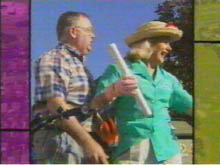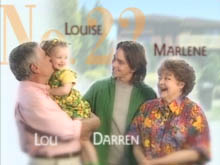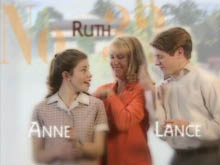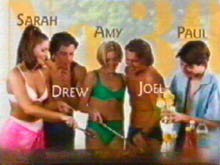|
.

Comment
> Eras of Erinsborough: Part Three
by Rhys
Following a severe drop in ratings during the 1994-95 seasons, it was accepted that something dramatic needed to be done to revitalise Neighbours and maintain interest in it following the tenth anniversary. And so, 1996 heralded the new ‘revamped Neighbours’.
|

|
However, it wasn’t so much a revamp as a reawakening and realisation that the show needed to be dealt with in an enthusiastic and genuine way, staying true to its roots and underlying appeal. On screen, the most noticeable change viewers noticed as the show began season twelve was the introduction of new, funky opening titles with jazzy colour filters and a purely Ramsay Street setting – distancing themselves from the look given to the show during the early 90s. Behind the scenes, however, events were more dramatic. Greg Stevens was brought in as Script Producer to oversee the general direction of the show having been at Home and Away for many years. Scott Taylor was appointed Story Editor and long term writer and former Script Supervisor during the early years, Ray Kolle, was also brought back to a more prominent role in the show’s production. Under Stanley Walsh’s guidance as Executive Producer, the premise was that the programme would become far more family-orientated than it had been for many years – echoing the original concept in 1985.
The main reason 1995’s season had flopped was due to a reliance largely on a stale cast which hadn’t seen any major development for several years. The Kennedy family’s introduction had failed to ignite interest in the show as it hoped they would and a lack of storylines had infamously led to episodes often ending spontaneously with no scripted cliffhangers. Although not always the best way forward, it was sadly the case that Neighbours needed to lose a number of characters that had become ‘boring’ and stagnant and gain some fresh new blood. Jen Handley, Annalise Hartman, Sam Kratz, Brett Stark, Cody Willis, Stonefish Rebecchi, Danni Stark, Luke Handley and Cheryl Stark disappeared throughout 1996 and in their place, the Wilkinson family, the return of Darren Stark and Debbie Martin’s return added to the existing family groups and managed to eradicate some of the waif and stray element that had crept into the show. A focus on more powerful stories, such as Helen’s stroke, Cody’s shooting, Billy and Anne’s relationship and Luke’s cancer kept interest during the revamp year as other changes were made to the cast.
|

|
The most shocking decision made was to reintroduce Madge and Harold to the programme. Anne Charleston as Madge had not been seen on screen since 1992, whilst Ian Smith’s Harold was presumed drowned in 1991 – and at first the decision to resurrect the supposedly dead character was seen as going a step too far in the wrong direction. However, the storyline was backed by the justification that Harold had survived his fall off rocks and spent the previous five years living as amnesiac, Ted, in Tasmania. However, to justify the couple’s return, the decision was made to axe the much-loved character of Lou Carpenter. It’s quite likely that Neighbours hadn’t anticipated quite how much of a following the loveable bar-owner had and following a massive campaign by fans to save him, he was back – albeit without on-screen partner Caroline Gillmer as Cheryl, who had a run in with a car bonnet a week earlier.
Neighbours’ popularity throughout 1996 increased, and it ended the year with not only the first Ramsay Street Christmas for many years, but also the life of soon-to-depart Malcolm Kennedy in he balance as he and father Karl fitted out the pub and transformed it from Chez Chez to the new Lou’s Place. On-screen a number of other sets were also transformed to modernise the programme’s appearance: the Coffee Shop took on the guise of a funky Hollywood diner, Nos. 24, 26, 28 and 30 were also redecorated as well as an explosion at the surgery which allowed changes to be made to that set. Neighbours entered 1997 with a new titles sequence which would last through until 1999, and used character names and house numbers for the first time (rumour had it that the previous year’s titles were deemed too ‘youthful’ for the show).
With a far ‘sunnier’ feel than in many years, 1997 was a triumphant year for Neighbours with Harold and Madge settling in well with the newer characters, whilst the Kennedys began finding their feet and they took in loveable Toadfish as a lodger. The relationship of Billy and Anne dominated storylines for a long while – in a bid to echo the success of Scott and Charlene in the 1980s with partial success, largely due to the ‘pin-up’ factor of Jesse Spencer and Brooke Satchwell, coupled with a “are they, aren’t they” scenario relating to the actors’ love lives. Ruth Wilkinson found love with Philip – again all relating to the returned ‘family’ ethos promoted following the revamp and allowed Philip some new material as opposed to being at a loose end as he had been, even with Jen.
|

|
1997-1998 are often recognised as successful years for the programme, having survived the impending axe of the mid-nineties, the new, revamped Neighbours was moving full steam ahead with a strong cast and interesting stories, maintaining the famous mix of comedy, drama and romance. Sadly, during 1997, one of the low-points of the show occurred with the death of the longest serving character, Helen Daniels. Anne Haddy’s failing health had worsened considerably during 1996-1997, to the extent that she had to take extended breaks from the set and storylines featuring Helen were often conducted without her ever appearing on-screen. Ray Kolle’s interview on this site chronicles the interesting journey the plotting of Helen’s departure took, but in the end she died peacefully on the sofa in the iconic No.26 living room, with the wedding video of Scott and Charlene playing to the gathered family members. Despite Helen’s death, the show coped remarkably with its stable cast throughout 1997 and ended the year with, arguably, one of the greatest season finales in its history – only surpassed by the most recent effort in 2004. A mix of four story threads (Ben’s massive car crash, Karl’s infidelity, Billy and Caitlin’s kiss and Philip’s marriage proposal) set up some of the major threads for 1998 and proved that after the watery stories ending seasons in the mid-90s that the show could pull out all the stops and really take viewers on a rollercoaster journey.
Phil and Ruth’s wedding was a highpoint of the 1998 season and enabled the Martin family to move up a gear and distance themselves from the Robinsons which was essentially needed to stop them becoming stale. Ben’s recovery following the accident was slow, but again was what was needed to engage viewers’ interest in a non-love related storyline. However, by far the biggest plot of 1998 was Karl and Sarah. Those two names are all that are needed to sum it up – one of the most successful stories ever run. Following the kiss in the 1997 finale, nothing more racy occurred between the doctor and his receptionist, but the crime Karl was most guilty of was not revealing the kiss to Susan, and then spending increasing amounts of time with Sarah as she studied for a nursing degree. Aware of the boundaries of the time slot Neighbours broadcasted in, the programme knew it couldn’t show any physical form of infidelity between them both, and so much of the story was based on viewer assumption, and the writers leaving seeds of doubt in our minds as to what actually went on between them both. The most prominent of which was towards the end of the story’s run as Karl and Sarah spent the night in a motel, but it was never made clear as to whether they had sex or not. On the day of Phil and Ruth’s wedding, things came to a head and Susan discovered the affair through Billy and a huge row ensued with the famous slap scene. The Kennedys split following the revelation and feelings towards Sarah were divided also. However, as the show entered 1999 and the final year before the twenty-first century, the Kennedys were reunited and Sarah was married off to medic, Peter Hannay.
|

|
Sadly, the renaissance the programme had enjoyed up until now was soon to come to an end. Almost as a sign of things to come, the 1999 season launched with a controversial new look. The theme song was updated to a more rock-based arrangement and the accompanying titles sequence utilised the best of Lolly Carpenter’s kindergarten drawings! One of the reasons behind the 1999 season’s lack of ability to gain viewer interest as much as the previous years is largely attributable to a focus on younger cast members, with the under-25 demographic taking centre stage, so to speak, and a shift towards the older cast members taking a back seat. However, there are some golden moments in the last season of the twentieth century to treasure – including the Full Monty storyline in which the male resident showed their bare cheek by showing their bare cheeks and the arrival of the Scully family in the latter half of the season.
During the year it had become obvious that the extended Robinson family were skating on thin ice, and that the Billy and Anne story had exhausted its on-screen run, as had Amy and Lance. Viewers had suddenly realised, after the excitement of 1998, that without Helen it was difficult to relate to the Martins as they had before, and so without nostalgia to save them the decision was taken to axe the Martin family, with Jesse Spencer and Brooke Satchwell leaving a few weeks later. Immediately filling the void at No.26 were the common and brash Scullys – quite a shock to middle class Ramsay Street. Regardless of initial hesitation, the family showed so signs of moving on soon, and so Joe, Lyn, Steph, Flick and Michelle integrated themselves amongst the residents. In a bid to warm them to viewers, the show took the brave decision of having them feature prominently in the 1999 season finale, set around a street Millennium party. The culmination of the episode saw No.26’s kitchen catch fire and Louise Carpenter trapped inside. Not a nice way to end the year, but with a new family firmly established, the arrival of sexy school teacher Teresa Bell and the relationship between Drew and Libby, a new era on Ramsay Street was dawning as quickly as the new Millennium.
To read the final part, click here...
Back |

